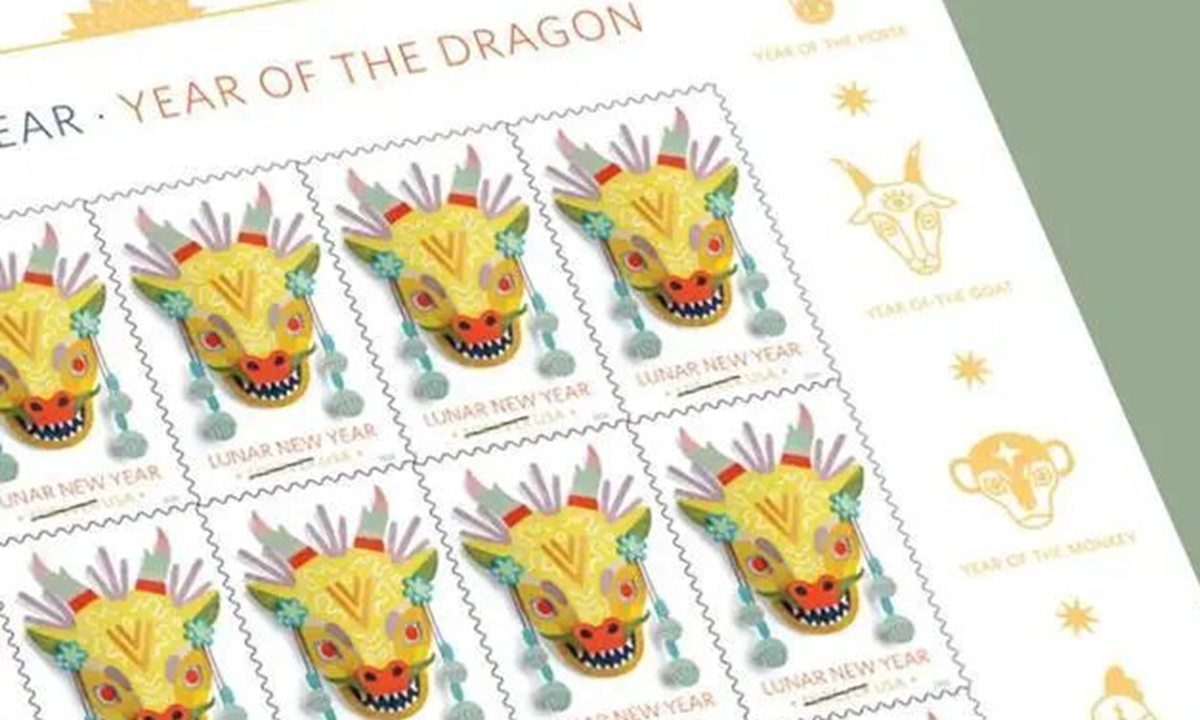
Photo: screenshot from online
The controversy that has arisen over a Year of Dragon stamp issued by the United States Postal Service (USPS) shows lack of understanding of the Chinese dragon's history and culture, highlighting the importance of respecting and promoting Asian culture in a genuine way.
According to a report from the San Francisco Standard, some Chinese Americans have criticized this zodiac stamp, saying it looks like both an "ox" and a "monkey." From the image, one can see that the dragon depicted on the stamp has red eyes, a red nose, a black mouth, white sharp teeth, and sunken cheeks, creating a grotesque and somewhat sleazy monster that is far from the traditional Chinese concept of dragons. Many Chinese netizens also commented that it looked like "a bizarre monster."
In Chinese culture, dragons hold significant status and influence. Some ancient books record that the typical depiction of a Chinese dragon includes features such as camel-like head, deer-like antlers, rabbit-like eyes, cow-like ears, snake-like necks, fish-scale-covered bellies, eagle-like claws and tiger-pawed palms.
The origin of the dragon does not have one unified explanation. However, one widely accepted theory among scholars is that the dragon evolved from totemic symbols used by ancient tribes in China. After winning tribal wars, victors would incorporate parts of defeated tribes' totems into their own totems through continuous assimilation within tribes. This process eventually formed the shape of the "dragon" which combines various animal forms together.
In traditional Chinese culture, dragons symbolize power, nobility, honor as well as luck and success. Throughout history, although there have been diverse representations and evolution in the depictions of Chinese dragons with rich source materials, overall they tend toward beauty, conforming to aesthetic principles. This consistency aligns with what these images reflect about Chinese people's pursuit toward goodness.
The Yangshao cultural site, where the "First Dragon of China" was unearthed in 1970, dates back to 7,000-5,000 years ago. Alongside human remains found were a nearly 2-meter-long dragon sculpture meticulously crafted from clam shells and a tiger figurine placed nearby. At this time, both the dragon and tiger had become symbols of status and identity.
The excavation of the Hongshan civilization artifacts revealed the image of dragons as perceived by ancient Chinese people 5,000 years ago. From the unearthed jade carvings, it is evident that jade dragons without claws were already appearing as ceremonial objects in Chinese ritual activities during that era.
The discovery of a large turquoise dragon-shaped bronze artifact at the Erlitou ruins from the late Xia or early Shang Dynasty (c.1600BC-1046BC) was given the name "Chinese Dragon" by Chinese archaeologists. This unearthing provided an orthodox origin for the Chinese nation's dragon totem.
The essence of the dragon represents Chinese people's perception, cognition, and deification of natural forces within the universe. After at least 8,000 or even 10,000 years of evolution and sublimation, dragons have become a spiritual emblem for the Chinese nation.
Most overseas ethnic Chinese identify themselves as descendants carrying on this broader meaning behind being associated with dragons in terms of humanistic significance. However, these postage stamps released by USPS seem unrelated to these auspicious connotations.
Pang Jin, an expert on dragon-phoenix culture studies, also expressed that those who designed these stamps either do not want to see or are unwilling to accept or express through artistic means China's beautiful image represented by its dragon along with its upward momentum toward goodness.
Since the target audience for the zodiac stamps is primarily Asian Americans in the US, it is important to design them based on a thorough understanding and respect for their historical and cultural origins.
This is not the first time that foreign institutions have sparked controversy with their release of zodiac stamps. These institutions could either solicit designs from the Asian community or seek public opinions before making an official release as a means of improvement. Only through sincere and thoughtful communication can we truly promote Asian culture and stories and show genuine respect.
The author is a reporter with the Global Times. life@globaltimes.com.cn




